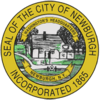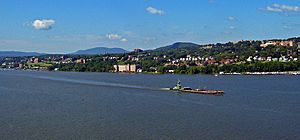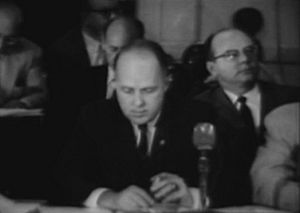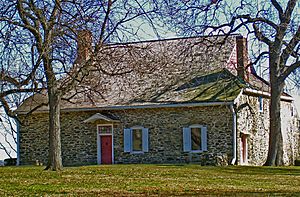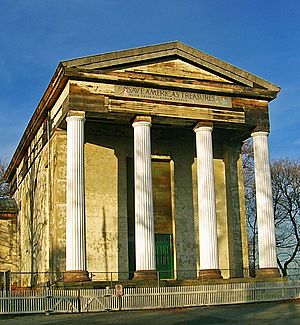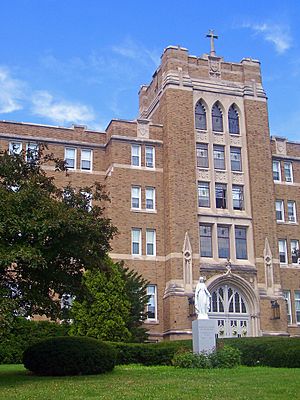Newburgh, New York facts for kids
Quick facts for kids
Newburgh
|
|||
|---|---|---|---|
| City of Newburgh | |||
Downtown Newburgh from Beacon,
across the Hudson River |
|||
|
|||

Location in Orange County and the state of New York.
|
|||
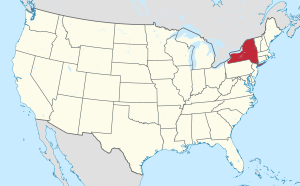
Location of New York in the contiguous United States
|
|||
| Country | |||
| State | |||
| County | Orange | ||
| Settled | 1709 | ||
| Village Incorporation | 1800 | ||
| City incorporation | 1865 | ||
| Government | |||
| • Type | Council–manager | ||
| Area | |||
| • City | 4.78 sq mi (12.39 km2) | ||
| • Land | 3.81 sq mi (9.86 km2) | ||
| • Water | 0.98 sq mi (2.53 km2) | ||
| Highest elevation | 690 ft (210 m) | ||
| Lowest elevation | 0 ft (0 m) | ||
| Population
(2020)
|
|||
| • City | 28,856 | ||
| • Density | 6,037/sq mi (2,329.0/km2) | ||
| • Metro | 670,301 | ||
| Demonym(s) | Newburgher | ||
| Time zone | UTC-5 (Eastern) | ||
| • Summer (DST) | UTC-4 (Eastern) | ||
| ZIP Code |
12550
|
||
| Area code(s) | 845 Exchanges: 561,562,563,565,568,569,863 | ||
| FIPS code | 36-071-50034 | ||
| GNIS feature ID | 0958498 | ||
| FIPS code | 36-50034 | ||
| Primary airport | Stewart International Airport | ||
| Interstates | |||
| U.S. routes | |||
| Website | www.cityofnewburgh-ny.gov | ||
Newburgh is a city in the U.S. state of New York, within Orange County. With a population of 28,856 as of the 2020 census, it is a principal city of the Poughkeepsie–Newburgh–Middletown metropolitan area. Located 60 miles (97 km) north of New York City, and 90 miles (140 km) south of Albany on the Hudson River within the Hudson Valley Area, the city of Newburgh is located near Stewart International Airport, one of the primary airports for Downstate New York.
The Newburgh area was first settled in the early 18th century by the Germans and British. During the American Revolution, Newburgh served as the headquarters of the Continental Army. Prior to its chartering in 1865, the city of Newburgh was part of the town of Newburgh; the town now borders the city to the north and west. East of the city is the Hudson River; the city of Beacon is across the river and it is connected to Newburgh via the Newburgh–Beacon Bridge. The entire southern boundary of the city is with the town of New Windsor. Most of this boundary is formed by Quassaick Creek. In May 2016, the city requested help for its PFOS contaminated water supply under Superfund.
Newburgh is the location of numerous preserved landmarks, including Washington's Headquarters, the David Crawford House, New York State Armory, the Dutch Reformed Church, and Newburgh Colored Burial Ground. George Washington and Franklin Delano Roosevelt had ties to the city; Ulysses S. Grant, Robert Kennedy, and Theodore Roosevelt also visited, the latter delivering a famous speech at a nearby shipyard. The city served as a planning ground for the Gothic Revival architectural movement in America, headed by native Andrew Jackson Downing with English architects Calvert Vaux and Frederick Clarke Withers.
Mount Saint Mary College is a private liberal arts college stimulating the city's population and economy. Major corporations with significant operations in the city of Newburgh are Stop & Shop, M&T Bank, Chase Bank, Verizon Communications, Charter Communications, Dunkin', McDonald's, Metro by T-Mobile, Boost Mobile, and Marshalls.
Contents
History
Exploration and settlement
At the time of European contact the area of Newburgh was occupied by the Waoranek, a branch of the Lenape. The area that became Newburgh was first explored by Europeans when Henry Hudson stopped by during his 1609 expedition up the river that now bears his name. His navigator, Robert Juet, is said to have called the site "a pleasant place to build a town", although some later historians believe he may actually have been referring to the area where Cornwall-on-Hudson now stands.
Around 1683 provincial governor Thomas Dongan purchased the land from the Woaranek. The first settlement was made in the spring of 1709 by fifty-four Palatine refugees, sponsored by Queen Anne of Great Britain. The settlers named it the Palatine Parish by Quassic. In 1743 a ferry at the foot of First Street had been established between Newburgh and Fishkill Landing. In 1752 the land had been surveyed by Cadwallader Colden and named "Newburgh" after Newburgh in his native Scotland. Shipyards were established and docks and warehouses lined the waterfront.
American Revolution
Newburgh was the headquarters of the Continental Army from March, 1782 until the latter part of 1783. While the army was camped at Newburgh, some of its senior officers began the "Newburgh conspiracy" to overthrow the government. General George Washington was able to persuade his officers to stay loyal to him. The army was disbanded here in 1783. Washington received the famous Newburgh letter from Lewis Nicola proposing that he become king here. It drew a vigorous rebuke from Washington. In honor of his refusal of that suggestion, Kings Highway, the north-south street on which the Newburgh headquarters is located, was renamed Liberty Street.
Growth in the 19th century

The year 1793 saw Newburgh's first newspaper, The Newburgh Packet. The hamlet of Newburgh was incorporated as a village in 1800. At the time of its settlement it was in Ulster County and was that county's seat. When Rockland County was split from Orange County in 1798, Newburgh and the other towns north of Moodna Creek were put in a redrawn Orange County. Newburgh thus lost its status as the county seat to Goshen. The former Ulster County courthouse still stands as Newburgh's old city courthouse building (currently used as municipal office space).
By 1793 there were four sloop lines operating out of Newburgh. As new turnpikes opened trade extended into the interior. Passenger coaches and farm wagons raveled as far west as Canandaigua. This was the shortest route from the Hudson to the West. By 1819 a steamboat on Cayuga Lake connected Newburgh stage lines with Ithaca. Streets leading to the river were often blocked for hours with farmers' wagons waiting to be unloaded at the wharves. With the opening of the Erie Canal much of the traffic from the Southern Tier was diverted. In 1830 Richard Carpenter of Newburgh had the steamboat William Young built at Low Point; it ran between Newburgh and Albany. Prosperity returned with the arrival of the railroads.
On he evening of September 24, 1824 beacon fires in the Highlands announced the arrival of the Marquis de Lafayette. Having been feted in New York, he sailed upriver on the chartered steamer James Kent. The next day, people came from the surrounding towns to catch a glimpse of the General as her made his way to a reception at the Orange Hotel. The Rev. John Brown of St. George's Episcopal Church was part of the welcoming committee. At 2 a.m. Lafayette sailed from Reeve & Falls dock for Poughkeepsie.
The Erie Railroad charter was amended April 8, 1845 to allow the building of the Newburgh Branch, running from the main line near Harriman north-northeast to Newburgh, also on the Hudson River. The branch opened January 8, 1850. It was later used as a connection to the New York and New England Railroad via a car float operation across the river to Beacon, New York.
Newburgh was chartered as a city in April 1865.
Newburgh became quite prosperous during the Gilded Age that followed. Newburgh had telephone service in 1879. In 1883 there was a steamboat landing on Second Street. The United States Hotel was on Front Street opposite the landing. Also on Front Street near the landing was the Union Depot. In 1883, the West Shore Railroad inaugurated service to the Pennsylvania Railroad Depot at Jersey City and by 1886 was traveling to Weehawken Terminal, where passengers transferred to ferries to Manhattan.
With its situation on the Hudson River, midway between New York City and Albany, it became a transportation hub and an industrial center. Its industries included manufacturings of cottons, woolens, silks, paper, felt hats, baking powder, soap, paper boxes, brick, plush goods, steam boilers, tools, automobiles, coin silver, bleach, candles, waterway gates, ice machines, pumps, moving-picture screens, overalls, perfumes, furniture, carpets, carburetors, spiral springs, spiral pipe, shirt waists, shirts, felt goods, lawn mowers; shipyards; foundries and machine shops; tanneries; leatherette works; plaster works.
J. J. Nutt made this comment about Newburgh: "The year 1891 finds us the most thriving city on the Hudson, with citizens full of spirit of public enterprise, with public institutions comparatively unequalled, and with apparently every factor and requisite to ensure its bright future as a manufacturing and commercial city of importance. . .".
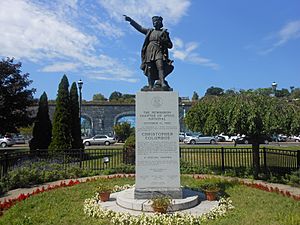
Newburgh was home to the second Edison power plant, installed to power 126 lamps at the Orange Woolen Mill, and was the second American city (after New York's Pearl Street) to have a street lighted using electricity. Broadway, which at 132 feet (40 m) in width is one of the widest streets in the state of New York, runs through the city culminating with views of the Hudson River.
20th century
Newburgh played a pivotal role in television history. In October, 1939, RCA chose to test-market televisions in Newburgh, which was within range of the television signal of RCA's experimental station W2XBS. 600 sets were sold in Newburgh at a deep discount. The test-marketing campaign's success encouraged RCA to go forward with developing the new medium. Additionally, with consumer television production ceasing during World War II, those Newburgh households which purchased televisions during 1939 and 1940 were among the few to enjoy television (albeit with a greatly reduced programming schedule) during the war.
Newburgh was one of the first cities in the country to fluoridate its water in 1945.
In the late 20th century the industrial base of the city declined as industries relocated operations south or to other locations with cheaper labor costs and lower taxes. The Hudson River, which previously served as the main means of transporting goods, lost much of its shipping traffic to trucking. The city's trolley system was shut down in 1924 in favor of buses. The nation moved to the automobile for transportation and, as with many other cities, there was a resulting migration to the suburbs. In 1963 the Newburgh–Beacon Bridge was opened, carrying Interstate 84 and spanning the Hudson River, bypassing the Newburgh waterfront and the City of Newburgh altogether. The ferry closed down soon thereafter − it was not revived until 2005 − and the waterfront area declined rapidly.
In 1962, Lloyd's Department Store became the first major shopping center in the Town of Newburgh. Its motto was "Years Ahead" and the motto proved prophetic. Many features of Lloyd's, including widely divergent ministores under one roof, did not become common in other shopping centers for many decades. Lloyd's successfully drew a great deal of retail business away from the downtown area. In 1964, the Mid Valley Mall opened, also outside of the city limits in the Town of Newburgh, and attracted many long-established local businesses away from the waterfront and downtown City of Newburgh. Other retail shopping malls soon sprang up, all also outside the City of Newburgh, and the retail portion of the City was doomed. The city continued to lose its previously well regarded retail sector along Water Street and Broadway to the suburban shopping malls, which did not share the City's congested parking and traffic problems — or the perceived rising crime rate.
In the late 1960s and early 1970s, the city's response to the economic decline was an ambitious urban renewal plan. The city's historic waterfront area, an area composed of several square blocks which included numerous historically significant buildings, was completely demolished between 1970 and 1973. Residents were relocated, or were supposed to be relocated, to newer housing projects around Muchattoes Lake in the city's interior.
A grand complex that was planned for the urban renewal area was never built when state and federal spending began to dry up after the 1973 oil crisis. To this day, the blocks which slope down to the river remain open, grassy slopes, offering sweeping views of the Hudson but generating no property taxes for the city. Public sentiment is mixed on whether they should be built on again at all, and the city's view-protection ordinances make it less likely. Below, the waterfront was developed in the late 1990s after the city was once again able to secure grants from the state's Environmental Protection fund for riprap (a type of stone) to stabilize the shoreline.
In the early 1960s, city manager Joseph McDowell Mitchell and the council attracted nationwide attention and the admiration of political conservatives when they attempted to require welfare recipients to pick up their payments at police headquarters. Mitchell later announced a program aimed largely at blacks on welfare, whom many in the community blamed for its economic problems. The program would have denied welfare payments to all after three months except the aged, the blind and the handicapped. Those affected would have largely been single mothers of young children, the only category in which blacks were predominant. After opposition by both state and federal officials, the program created a national controversy and never went into effect. Along with the failed urban renewal, the mid to late 1960s in Newburgh were also marked by race riots and other tensions.
Newburgh in the early 21st century is more racially diverse than it used to be, as a growing Latin immigrant (mainly of Mexican descent) population complements the city's sizable African American contingent. Economic development is a major concern, but poorly realized, as the good jobs once found in the local manufacturing sector have not been replaced. Pockets of poverty persist in the city, often mere blocks away from its many historical and architectural landmarks. In addition to this, the city has been facing issues regarding illegal immigration, like many other cities across the United States, ranging from overcrowded apartment buildings to mild racial conflict.
In spite of this Newburgh is experiencing a spurt of new businesses on its historic Liberty Street near Washington's Headquarters. An art supply store, a gourmet food market, an antique store, a used furniture shop, a souvenir shop, a flower shop, a bakery and a restaurant have joined an existing cafe, a graphic design shop and two additional antique stores in the final months of 2008 and January 2009. This is all in the midst of the redevelopment of East Parmenter Street in a partnership with Habitat for Humanity and a private developer to build 24 new houses. The city has completed the overhaul of the infrastructure of the street.
Preserving the past
Newburgh's preservation history can be traced all the way back to 1850 when Washington's Headquarters was designated a state historic site, the first in the country. The Historical Society of Newburgh Bay and the Highlands was chartered by the State of New York. Incorporated in 1884. The David Crawford House, on Montgomery Street, built in 1834 by Captain is the current home of the Newburgh Historical Society.
The city's modern preservation efforts began when the Dutch Reformed Church, a Greek Revival structure designed by Alexander Jackson Davis, was slated for demolition as part of urban renewal after the congregation left the decaying building in 1967. The movement to stop it led to the development of a historic district, now the second largest in New York State. The church was added to the National Register of Historic Places three years later, and in 2001 became the city's second National Historic Landmark after Washington's Headquarters.
The city was designated a Preserve America community in 2005 and it also signed an agreement with the State Office of Historic Preservation as a Certified Local Government community. Its East End Historic District, recognized by the National Register of Historic Places as that and the Montgomery-Grand-Liberty Streets Historic District, has the most contributing properties of any historic district in the state.
The city's historic architecture, featuring historic designs by Calvert Vaux, Andrew Jackson Downing and Frederick Law Olmsted, has attracted a stable core of preservation-minded community activists willing to invest spend time and money in renovating property.
Belknap Stone House
Located on Broadway, the Belknap house was built around 1750 as is the second oldest house in he city. Belknap chaired the local Committee of Safety during the war. The house served as James Clinton's headquarters.
Newburgh Colored Burial Ground
Newburgh Colored Burial Ground is a historic cemetery and national historic district located at Broadway and Robinson Avenue. The 19th-century burial ground was active between about 1832 and 1867 and contains approximately 100 graves.
Montgomery-Grand-Liberty Streets Historic District
- Old Town Cemetery (Newburgh, New York)
- David Crawford House
- Dutch Reformed Church (Newburgh, New York)
- United States Post Office (Newburgh, New York)
East End Historic District (Newburgh, New York)
Geography

The city is on the west bank of the Hudson River. Next to it, the land rises at first sharply to a bluff, where many historic homes are located due to the sweeping views it offers of the Hudson Highlands to the south, Mount Beacon to the east and the bridge to the north; then more gradually to a relatively level western half. There are some notable hills in outlying areas, such as Overlook Terrace in the city's southeast corner and Mount St. Mary's at the northeast.
The lowest elevation in the city is sea level along the river; the highest is roughly 690 feet (210 m) on Snake Hill along the city's southern boundary with the Town of New Windsor.
Newburgh is located at (41.503193, −74.019636).
According to the United States Census Bureau, the city has a total area of 4.8 sq mi (12.4 km2). 3.8 sq mi (9.9 km2) of it is land and 0.97 sq mi (2.5 km2) of it (20.08%) is water.
Climate
| Climate data for Newburgh | |||||||||||||
|---|---|---|---|---|---|---|---|---|---|---|---|---|---|
| Month | Jan | Feb | Mar | Apr | May | Jun | Jul | Aug | Sep | Oct | Nov | Dec | Year |
| Record high °F (°C) | 71 (22) |
71 (22) |
85 (29) |
96 (36) |
97 (36) |
102 (39) |
103 (39) |
103 (39) |
105 (41) |
89 (32) |
82 (28) |
72 (22) |
105 (41) |
| Average high °F (°C) | 35 (2) |
39 (4) |
48 (9) |
61 (16) |
71 (22) |
80 (27) |
85 (29) |
83 (28) |
75 (24) |
63 (17) |
51 (11) |
40 (4) |
61 (16) |
| Average low °F (°C) | 20 (−7) |
23 (−5) |
29 (−2) |
40 (4) |
50 (10) |
59 (15) |
64 (18) |
63 (17) |
55 (13) |
45 (7) |
36 (2) |
26 (−3) |
43 (6) |
| Record low °F (°C) | −15 (−26) |
−11 (−24) |
0 (−18) |
15 (−9) |
27 (−3) |
40 (4) |
45 (7) |
41 (5) |
32 (0) |
22 (−6) |
10 (−12) |
−7 (−22) |
−15 (−26) |
| Average precipitation inches (mm) | 3.66 (93) |
3.20 (81) |
3.89 (99) |
4.13 (105) |
4.11 (104) |
4.56 (116) |
4.59 (117) |
4.61 (117) |
4.47 (114) |
4.99 (127) |
4.33 (110) |
4.20 (107) |
50.74 (1,289) |
| Source: The Weather Channel | |||||||||||||
Demographics
| Historical population | |||
|---|---|---|---|
| Census | Pop. | %± | |
| 1860 | 12,578 | — | |
| 1870 | 17,014 | 35.3% | |
| 1880 | 18,049 | 6.1% | |
| 1890 | 23,087 | 27.9% | |
| 1900 | 24,943 | 8.0% | |
| 1910 | 27,805 | 11.5% | |
| 1920 | 30,366 | 9.2% | |
| 1930 | 31,275 | 3.0% | |
| 1940 | 31,883 | 1.9% | |
| 1950 | 31,956 | 0.2% | |
| 1960 | 30,979 | −3.1% | |
| 1970 | 26,219 | −15.4% | |
| 1980 | 23,438 | −10.6% | |
| 1990 | 26,454 | 12.9% | |
| 2000 | 28,259 | 6.8% | |
| 2010 | 28,866 | 2.1% | |
| 2020 | 28,856 | 0.0% | |
| U.S. Decennial Census | |||
Newburgh's census-estimated population according to the American Community Survey was 28,282 in 2018, down from 28,866 in 2010. There were 11,765 housing units in 2018. The city's inhabitants were 20.1% non-Hispanic white, 24.2% African American, .3% American Indian or Alaska native, 1.1% Asian, .5% from some other race, 2.9% from two or more races, and 50.8% were Hispanic or Latino of any race in 2018. Of the Hispanic or Latin American population, Mexicans numbered 5,093 (18.0%), Puerto Ricans 3,337 (11.8%), Cubans 44 (.2%) and other Hispanic or Latin Americans 5,893 (20.85%). A sizable Asian community of Chinese, Filipino, Vietnamese, and Korean Americans resided in the city. The largest multiracial groups were black-white mixed race people and Eurasians.
There were 9,358 households, out of which 20.0% had children under 6 living with them and 52.4% had children aged 6 to 17. 42.0% of households had one or more people under 18 years and 30.4% had one or more people aged 60 and older living. The average household size was 2.92. In 2018, there were 5,752 families with an average family size of 3.8. Among unmarried-partner households, .9% were same-sex and 9.4% were opposite sex.
31.7% of the population was under the age of 18, 68.3% were 18 and older, and 9.4% were aged 65 and older. The median age was 29.1 years, a slight increase since 2000's census. For every 100 females, there were 88.1 males living in Newburgh. 55.4% of the city only spoke English and 44.6% spoke a language other than English. 41.5% understood Spanish in 2018 and 2.6% spoke another Indo-European language. 0.3% spoke Pacific Islander languages.
The median income for a household from 2014-2018 was $37,900 and the mean income was $53,772. 51.5% were below the poverty level and 84.5% were at or above the poverty level. Despite progress from the early 1990s, poverty remained a significant problem. The 2000 census found that two of the city's five census tracts were among the poorest in the entire state. In 2004 the state declared it one of the state's five most "stressed" cities, based on a mix of statistics like families headed by single mothers, abandoned buildings, unemployment, residents under the poverty line and adults without a high school diploma.
Religion
According to Sperling's BestPlaces, 53.5% of Newburghers are religious. The largest Christian denomination in the city is the Catholic Church (35.7%), served by the Roman Catholic Archdiocese of New York. 2.1% of Christians profess Methodism, 1.9% are Presbyterian, 1.2% Lutheran, 1.1 Pentecostal, 1.0% Anglican or Episcopalian, 0.5% Baptist, and 0.4% from the Latter-Day Saint movement. 1.7% are of another Christian faith which may consist of the Eastern Orthodox Church and others. The second largest religious demographic are adherents to Judaism. Jews form 6.5% of the Newburgher faith community. The Jewish Federation of Orange County is headquartered in the city and Congregation Agudas Israel and Temple Beth Jacob are located in the city limits. 1.1% of the faith community follow Islam and 0.2% are members of an eastern religion including Hinduism, Buddhism, or Sikhism.
St. George's Episcopal Church
In 1728 the Rev. Richard Charlton was sent from England to be a missionary to the people of New Windsor in then Ulster County (later Newburgh in Orange County). St. George's Church developed from St. Thomas' Church in New Windsor. In 1770, during the tenure of the Rev. John Sayre, St. George's Church was granted a royal charter by King George III. The Rev. Mr. Sayres left for Canada at the time of the Revolution. In 1790 Rev George Spierin served as both minister and schoolmaster, but resigned in 1793. St. George's Church was re-established in 1805. In 1838 the Rev Dr. John Brown organized St. George's Cemetery, open to members of any race, religion or belief. He was also a founder of St. Luke's Hospital. Originally, services were held in the old Glebe schoolhouse until the church was built in 1819. In 1834 the bell tower was added. Dr. Brown was succeeded by his assistant, Rev. Octavius Applegate who founded the mission chapel, of the Good Shepherd.
St. Patrick's Roman Catholic Church
The first Catholic service in Newburgh took place around 1816 when Mass was said in the house of Henry Gilmore on Western Avenue (now Broadway) by Rev. James McKenna. He was followed in 1817 by Rev. Ffrench. A church was formed in 1826, served by circuit-riding missionaries. Rev. Philip O'Reilly made Newburgh the base from which he served other communities. St. Patrick's Church was founded in 1836. Fr. Patrick Duffy was the first pastor and served for seventeen years until his death in 1853. He was followed by Rev. Gallagher, who was succeeded by Rev. Edward J. O'Reilly. Father O'Reilly was followed by Father Broidy. A stone church building was completed in December 1842 and formally dedicated by Bishop John Hughes of New York in 1849. In 1852 land was purchased for a cemetery at the corner of First and Stone streets. The rectory was built in 1854. The parish established in 1855 a Library Association, later known as the Young Men's Catholic Lyceum. In 1881 a new building was erected for the Lyceum on Liberty St.
In 1879 Right Rev. Monsignor J.F. Mooney became pastor and started the mission of St. Joseph's in New Windsor. He also founded Calvary Cemetery which opened on May 30, 1898.
St. Patrick's began its Hispanic ministry in the mid-1960s. In 1966 Father John Filippelli of the Society of Saint Joseph of the Sacred Heart initiated a Spanish Mass as well as cultural celebrations such as the Feast of Three Kings. In 1973, Fr. Rogelio Cuesta, OP was named Director of the Hispanic Apostolate of Newburgh and Beacon. Other patronal feasts were celebrated such as Our Lady of Charity from Cuba, Señor de los Milagros of Peru, and Our Lady of Suyapa of Honduras, reflecting the diversity of the community. In 1989 the ministry was expanded to include outreach to migrant workers.
St. Mary's Roman Catholic Church
St. Mary's Church was founded on March 19, 1875, on the application of a number of members of St. Patrick's to Archbishop McCloskey, who granted an order dividing the original parish and constituting from the northern part of its territory St. Mary's parish. Rev. Michael J. Phelan was appointed pastor, and said his first mass in the parish on Easter Sunday, 1875, in the opera-house. The Wilson property at Gidney Avenue and South Street was purchased and mass celebrated in the mansion on the premises. In May following a temporary frame building for church purposes was erected. In 1880 the building occupied by the church until 2015 was erected. It was dedicated by Archbishop McCloskey on Sunday, October 3. The Academy of Our Lady of Mercy (a branch convent of the Sisters of Mercy of New York), which was opened at Balmville in the summer of 1875. In 1883 Father Phelan invited the Sisters of Dominic to open an academy for young ladies and Mt. St. Mary's Academy was founded. In 1884 the Rev. John C Henry appointed rector and opened St. Mary's Parochial School on September 1, 1886. under the direction of four Sisters of St. Dominic.
In 2005, the Roman Catholic Archdiocese of New York decided to close St. Mary's Church as a cost saving measure. The people of the parish, and of the Newburgh community as a whole, rose up in protest and the Archdiocese withdrew the proposal. Then, in the summer of 2015, the archdiocese proposed closing the parish yet again, and while the community protests eclipsed those of 2005, this time the proposal was carried through. St. Mary's Parish was merged with St. Patrick's effective August 1, 2015. The church building was shuttered and closed and has not been used since that date. Father William Scafidi, the pastor and arguably the most popular community leader in Newburgh at that time, was transferred by the Archdiocese to a parish church in Liberty, New York.
St. Francis of Assisi Roman Catholic Church
In December 1908, Father Francis Fabian, pastor of Immaculate Conception Parish in Rondout visited Newburgh. Seeing that there the city had only two churches serving a large Catholic population, Fr. Fabian began to look into establishing another parish. Meetings were held and funds were raised and on April 22, 1909, Archbishop John Farley of New York appointed Fr Fabian pastor of the new congregation. Land was purchased at Benkard Avenue and Avoca Street and by May a temporary chapel was started. By August 15, 1909, the first Mass was celebrated in a small chapel on Benkard Avenue.
In May 1911, construction began on the main church, designed by Fabian in the style of a traditional European Basilica. The bricks were donated by nearby brickyards and transported from the different yards to the dock in Newburgh free of charge. Gustave Fettweise donated a bell. The church was completed on August 15, 1909, and a rectory completed that same year. The parish grew so rapidly that two-year later excavation was begun for a new stone church on a hill east of the rectory. Services were continued in the old chapel until September 1, 1913 when the new church was dedicated. The interior has beautiful Bavarian stained glass windows and a large mural behind the altar that was painted in Bavaria. The Tracker organ was built in 1862. It has 2600 pipes and two keyboards. The interior was completely renovated in 2000.
Sacred Heart Roman Catholic Church
Sacred Heart Parish traces its roots to when Rev. John B. Gallo came to Newburgh to minister to the spiritual needs of the Italian-speaking people who had been attending Mass at St. Patrick's Church. The parish became separate from St. Patrick's on September 8, 1912. Land was purchased on the southeast corner of Robinson Avenue and Ann Street. A temporary chapel situated in a vacant store at 286 Washington Street was used until the church was completed. The first Mass was celebrated in the new church on the Feast of the Immaculate Conception, December 8, 1913. Rev. Cyrus Falco was the pastor who guided the parish through the trying years of the Great Depression. In 1933 he invited the Sisters of St. Dominic to take charge of our parish Sunday School. Rev. John B. Caldarola was pastor during World War II.
Rev. Salvatore Celauro became pastor in 1947. The groundbreaking ceremony for the parish school was held on April 23, 1950 and school opened on September 9, 1951. In the mid-1950s it became apparent that a new church was needed as repairs would not be cost-effective. Work began in May 1963 and the first Mass in the new church was said on Christmas Eve, 1964. In September 1967 Rev. Salvatore Cantatore was named pastor of Sacred Heart and in October 1978, opened the Sacred Heart Parish Center. Msgr. George J. Valastro became pastor in 1981 and saw the parish celebrate its o75th Anniversary in 1987. Msgr. Valastro purchased the building at 319 Broadway which became the Activity Center.
Transportation
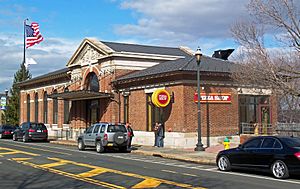
Allegiant Air, American Eagle and JetBlue airlines provide passenger flights Stewart International Airport, west of the city. Metro-North Railroad, at Beacon station on the opposite east shore of the Hudson River, accessible via the Newburgh–Beacon Ferry during peak hours, connects to commuter rail service on the Hudson Line, with frequent commuter rail service to Westchester County and Grand Central Terminal in New York City. There is also service on the Metro-North Railroad Port Jervis Line from nearby Salisbury Mills—Cornwall station to Hoboken Terminal and Secaucus Junction in New Jersey and connects to Penn Station in New York City. The last Albany-Weehawken trains through Newburgh left in 1958 when the New York Central ended service north of West Haverstraw on the West Shore Railroad.
The River Rose is a sight-seeing ferry on a paddlewheel style boat. While it does not offer point-to-point commuter service across the Hudson River, from May 31 to October 31 it offers local cruises. Hudson River Adventures runs sightseeing tours on its conventional style cruise Pride of the Hudson, running cruises, May to October.
Ulster County Area Transit provides limited bus service to New Paltz on its route X. Short Line, part of Coach USA, provides daily service down Route 32 to Central (Hudson) Valley and points in New Jersey and New York City. Local service is also provided within the city. Leprechaun Lines also provides a Newburgh-Beacon-Stewart link. Coach USA also provides transportation to other points in Orange County, including Middletown and Woodbury.
New York State Route 32 and U.S. Route 9W pass through the city. New York State Route 17K and New York State Route 207 also reach their eastern termini within city limits. Interstate 84 passes just north of the city and the New York State Thruway (I-87) not far to the west.
Economy
Newburgh was once a major economic hub between New York City and the New York State capital of Albany. Partly due to suburbanization and other economic factors the city suffered an economic decline from the 1960s to first quarter of the 21st century. Currently over 11,400 residents are employed within the city limits.
The largest industries as of 2020 were retail, healthcare and social assistance, food services, finance, public administration, and educational services. Being in close proximity to other major Northeastern cities, it serves as a significant location for Stop & Shop, M&T Bank, Chase Bank, Verizon Communications, Charter Communications, Dunkin', McDonald's, Metro by T-Mobile, Boost Mobile, and Marshalls.
Sports
Delano-Hitch formerly served as the home field for the Newburgh Black Diamonds and Newburgh Nighthawks baseball teams.
The Hudson Valley Renegades are a minor league baseball team affiliated with the New York Yankees. The team is a member of the New York–Penn League, and play at Dutchess Stadium in nearby Fishkill.
The Hudson Valley Highlanders of the North American Football League played their home games at Dietz Stadium in nearby Kingston.
Education
In 1978, students at Newburgh Free Academy, the city's public high school, boycotted classes. This ultimately led to a major reorganization of the school system. Newburgh is served by the Newburgh Enlarged City School District.
The local high school is called Newburgh Free Academy, and it is the largest public high school in Orange County. It serves approximately 3,000 students in grades 9–12 from the Newburgh area. Newburgh Free Academy is currently split into three campuses, with NFA Main located on Fullerton Avenue, NFA North located on Robinson Avenue a few blocks away, and NFA West located on West Street. Between the three campuses, there are roughly over 4,300 students enrolled. Two colleges are located in Newburgh, Mount Saint Mary College and the Newburgh campus of SUNY Orange.
Notable people
- Shad Barry, former MLB player
- William W. Belknap (1829–1890), U.S. Secretary of War
- Harry Griffith Cramer Jr. (1926-1957) US Army Special Forces captain, first American soldier killed in the Vietnam War
- James Cromitie, leader of the 2009 Bronx terrorism plot
- Elias Smith Dennis (1812–1894), U.S. Army general
- Andrew Jackson Downing (1815–1852), architect and landscape designer
- Geraldine Ferraro (1935–2011), Democratic Member of the U.S. House of Representatives (1979–1985) and the Democratic vice presidential candidate in 1984
- Pardison Fontaine (1989-), singer, songwriter and rapper
- Michael C. Gross (1945–2015), artist, designer and film producer. Gross designed the logo for the movie Ghostbusters and was the Art Director for National Lampoon from 1970 to 1974
- William S. Hart (1864–1946), actor
- Edward Howell (1792–1871), former U.S. Congressman
- William T. Innis (1826–1901), Wisconsin state legislator and farmer
- Augustus Jones (1757–1836), American-born surveyor who performed some land transfers in Newburgh area before embarking his career and majority of life in Upper Canada (now Ontario)
- Ellsworth Kelly (1923–2015), artist
- Judy Kennedy, (1945–2018), politician and businesswoman, Mayor of Newburgh
- Jeff Klein (1976–), singer, songwriter and musician
- Lee Lorenz, cartoonist
- Rob Affuso, former drummer of the band Skid Row
- Martin B. McKneally (1914–1992), national commander of the American Legion (1959–1960) and was a Republican member of the U.S. House of Representatives (1968–1970)
- Albert J. Myer (1828–1880), United States Army general
- Benjamin Barker Odell, Jr. (1854–1926), Republican member of the U.S. House of Representatives (March 4, 1895 – March 4, 1899) and Governor of New York State (1900–1904)
- James Patterson (1947–), novelist
- David Law Proudfit (1842-1897), poet and lithographer
- Homer Ramsdell (1810—1894), influential businessman and railroad president
- George D. Ruggles (1833–1904), Adjutant General of the U.S. Army from 1893 to 1897
- Fannie Morris Spencer (1865-1943), organist and composer
- Joe Steffy, football player for Tennessee and Army, Korean War veteran
- Paul Teutul Sr. (1949–), founder of Orange County Choppers, a manufacturer of custom motorcycles
- Albert W. Van Duzer (1917–1999), bishop of the Episcopal Diocese of New Jersey, serving from 1973 to 1982
- James Varick (1750—1827) first bishop of the African Methodist Episcopal Zion Church
- Coulton Waugh (1896–1973), artist (of Dickie Dare comic strip) and mapmaker
- Saul Williams (1972–), poet, actor and hip hop artist
- John E. Wool (1784–1869), officer in the U.S. Army
Images for kids
See also
 In Spanish: Newburgh (Nueva York) para niños
In Spanish: Newburgh (Nueva York) para niños



